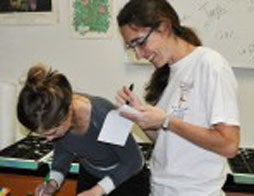Did you know soil environment can influence the color of hydrangea flowers? Or that you’re most likely to see insects when it is a particular temperature? This idea – called plasticity – impacts everything from your flower garden to agribusiness and even organisms’ response to climate change.
College of Charleston Biology Professor Courtney Murren led the recent publication of research that suggests biologists look at plasticity in a new way.
[Related: Read the article, published in The American Naturalist.]
 “Most scholars look at the mean change in traits. We’re the first to take a synthetic look at how species diverge in both the slope and curve of response to the environment– across plants, invertebrates and vertebrate animals,” Murren explains. “If we want to make predictions of the future for climate change or for an invasive species, this work shows that it might not just be a shift in the mean of that trait, but other aspects of how it responds in that environment might play a role.”
“Most scholars look at the mean change in traits. We’re the first to take a synthetic look at how species diverge in both the slope and curve of response to the environment– across plants, invertebrates and vertebrate animals,” Murren explains. “If we want to make predictions of the future for climate change or for an invasive species, this work shows that it might not just be a shift in the mean of that trait, but other aspects of how it responds in that environment might play a role.”
Murren, a plant evolutionary ecologist, hatched the idea for this research, then she and project co-leader Carl Schlichting (Univ. of Connecticut) brought together top scholars in amphibians, fish, plants at the National Evolutionary Synthesis Center in Durham, N.C. The Center’s mission is to address fundamental challenges in evolutionary science. The Center, thus the group’s research, is funded by a grant from the National Science Foundation (NSF).
“We used existing data in new ways to look at invertebrates, vertebrates and plants,” Murren says. “We were really interested in the impact of traits, type of trait and novelty of environment on the species. How can we better predict future responses of organisms to environmental change?”
[Related: Learn about Murren’s research on ecological genomics with College Professors Rutter and Strand.]
The group also investigated the cost of plasticity, and envisions other follow-ups like the use of more than two environments or looking at some of the aspect they highlighted as key to the divergence.
Members of the working group include: Courtney J. Murren, Heidi J. Maclean (University of North Carolina, Chapel Hill), Sarah E. Diamond (Case Western), Ulrich K. Steiner (University of Southern Denmark ), Mary A. Heskel (Australian National University ), Corey A. Handelsman (Colorado State University), Cameron K. Ghalambor (Colorado State University), Josh R. Auld (West Chester University), Hilary S. Callahan (Barnard College, Columbia University), David W. Pfenning (University of North Carolina, Chapel Hill), Rick A. Relyea (University of Pittsburgh), Carl D. Schlichting (University of Connecticut), Joel Kingsolver (University of North Carolina, Chapel Hill).
For more information, contact Courtney Murren at murrenc@cofc.edu.




